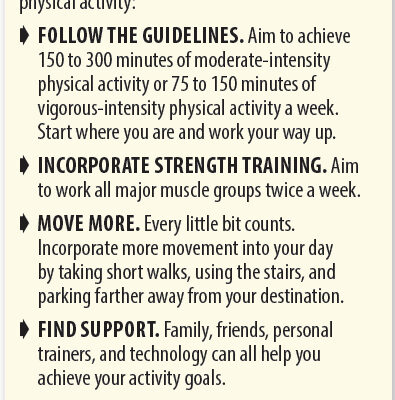Let’s Get Moving!
The benefits of physical activity are well-established. Not only can being physically active make you feel and perform better, but it can also reduce the risk of developing many chronic diseases, including cardiovascular disease, type 2 diabetes, and Alzheimer’s disease and other dementias.
Every Little Bit Counts.
The evidencebased recommendations in the Physical Activity Guidelines for Americans say we should engage in 150 to 300 minutes a week of moderate-intensity physical activity or 75 to 150 minutes a week of vigorous-intensity physical activity that increases your heart rate (aerobic activity). Muscle-strengthening activities that target all major muscle groups (legs, hips, back, chest, abdomen, shoulders, and arms) should be included at least two days a week (see Your Guide to Moving More for suggestions). Balance training, such as heel-to-toe walking, standing on one foot, yoga, tai chi, and riding a bike is important as well, especially for adults aged 65 and older.

If that sounds like a lot to you, Roger Fielding, PhD, senior scientist of the Nutrition, Exercise Physiology, and Sarcopenia Lab at the HNRCA says, “it’s better to do something rather than nothing.” Reducing long periods of inactivity is beneficial, even if sitting is replaced by light intensity activity (such as walking slowly or performing household chores). “Even though every little bit counts, there is a dose response effect with physical activity,” says Fielding. “The more you do, the lower your risk is going to be.”
If you are already active but want to step up your game, increase the speed, time, or distance of your aerobic activity or the weight or repetitions of your strength training.
It’s Never Too Late.
If you are not currently active, you can still reap the benefits of physical activity at any age by starting. There are many free resources offered online to help you get going (see Resources). Free or paid smartphone apps and wearables like rings and smart watches may help you stay motivated by allowing you to set goals and track activity. “If you’re not sure where to start or are afraid of getting injured, going someplace for supervision and structure can be helpful,” says Fielding. In addition to health clubs and gyms, your local YMCA, community center, or adult school typically offer physical activity programs.
There is no one-size-fits-all approach to physical activity. Try different activities until you find the ones you like for every time of year. The more you enjoy being active, the more likely you are to stick with it and ultimately experience its widespread benefits.

The post Let’s Get Moving! appeared first on University Health News.


